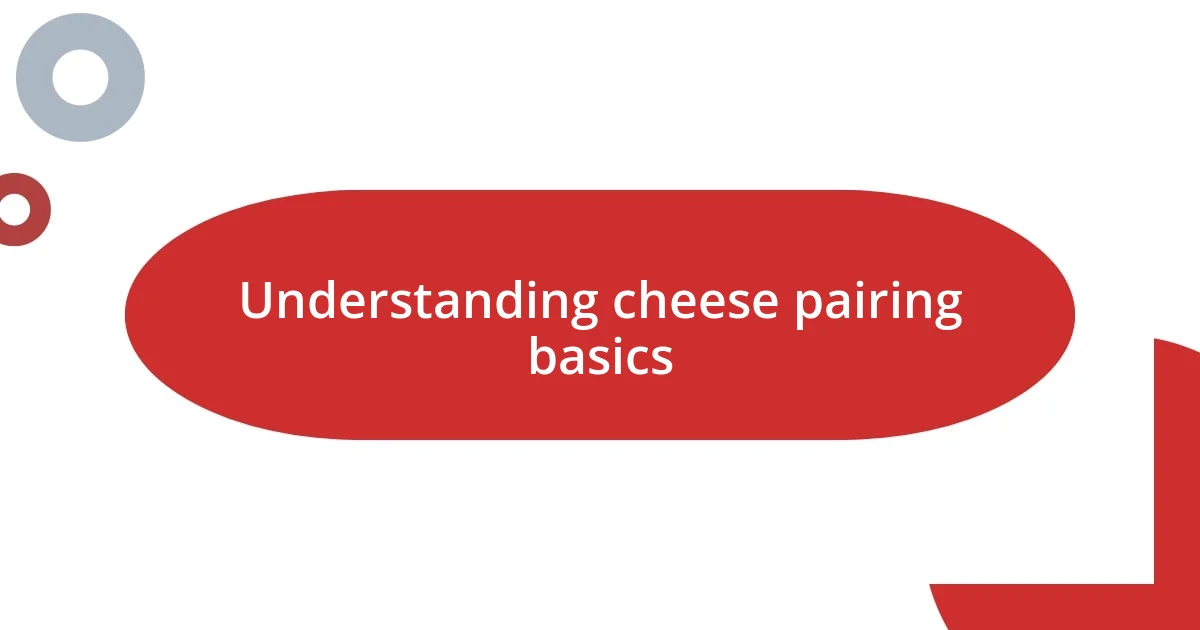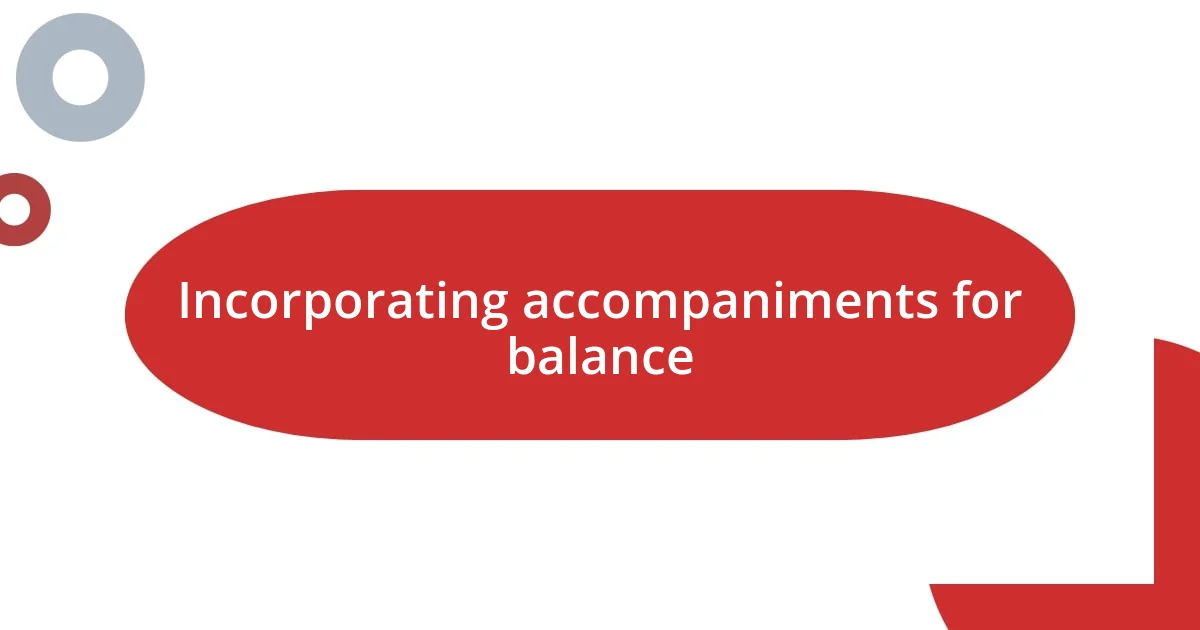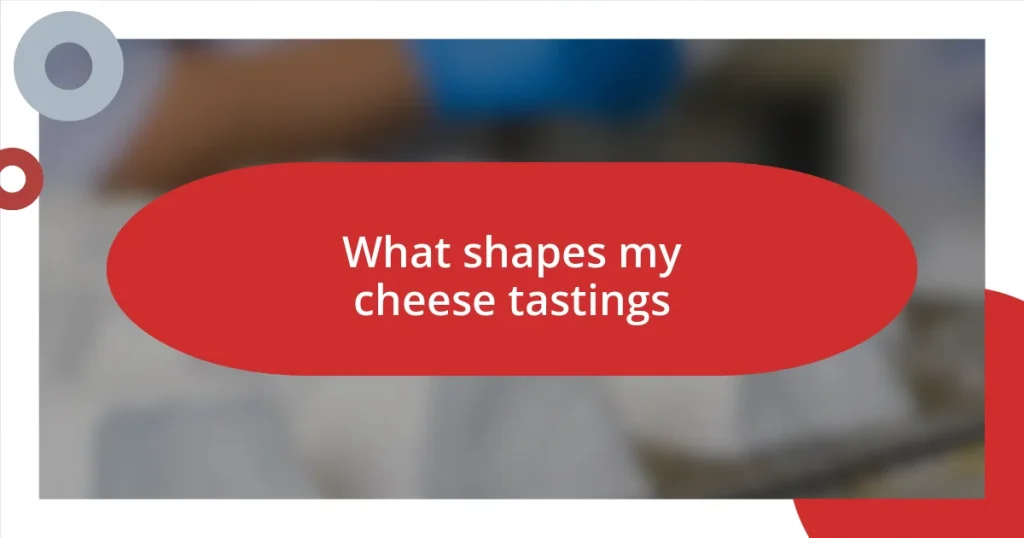Key takeaways:
- Cheese pairing involves balancing flavors, textures, and aromas, with successful combinations often enhancing the overall dining experience.
- Exploration of cheese flavor profiles considers factors like milk source, aging process, texture, and regional influence, which all contribute to unique taste experiences.
- Documenting pairing experiences helps deepen appreciation and reveals personal preferences, enhancing the journey of refining cheese pairing skills.

Understanding cheese pairing basics
Cheese pairing is all about balancing flavors and textures. I remember the first time I grabbed a slice of sharp cheddar and paired it with a fruity Merlot. The way the bold flavors danced together opened my eyes to how much life these pairings can bring to a table. Have you ever noticed how certain combinations can elevate even the simplest of meals?
Understanding the basics of cheese pairing means considering a few key factors: texture, flavor intensity, and aroma. For instance, creamy cheeses like Brie often pair beautifully with something sweet, such as honey or figs, to complement their richness. I often find myself experimenting with these combinations, and it’s fascinating to see how a little contrast can take your palate on an unexpected journey.
One of the principles I cherish is the idea that similar flavors tend to work well together—like pairing aged Gouda with a nutty brown ale. There’s an emotional satisfaction that comes from discovering what works for you personally. What has been your favorite pairing? I’d bet it carries a memory or a story that enhances your experience.

Exploring cheese flavor profiles
Exploring the flavor profiles of cheese can be an inspiring adventure. Each cheese tells a unique story through its taste and aroma, inviting us to delve deeper into the myriad of experiences they offer. I recall once savoring a pungent Roquefort alongside crisp pears; the contrast between the creamy, salty cheese and the juicy sweetness was electric, awakening my taste buds and enhancing the overall experience.
When examining flavor profiles, it helps to consider these key characteristics:
- Milk Source: Cow, goat, and sheep milk contribute distinct flavors. For example, goat cheese often has a tangy kick, while cow’s milk tends to be creamier.
- Aging Process: The aging period shapes acidity and complexity. Aged cheddar develops sharper, deeper flavors, unlike its younger counterpart.
- Texture: Texture influences mouthfeel and flavor perception. Soft cheeses like Camembert can feel luxurious, while hard cheeses like Parmigiano-Reggiano offer a satisfying crunch that enhances nuttiness.
- Regional Influence: Local climates and feed impact taste. A French Brie might taste markedly different from an American version, reflecting terroir, or the local environment’s influence on flavor.
Each characteristic enriches my understanding of cheese, reminding me that there’s always something new to uncover in each bite. What are some flavor experiences you’ve had that transformed your perception of cheese?

Identifying suitable wine pairings
Identifying suitable wine pairings can be a delightful process, yet it often requires a keen sense of balance. I always remember a night spent experimenting with a fresh goat cheese and a citrusy Sauvignon Blanc. The bright acidity of the wine not only cut through the cheese’s creaminess but also complemented its tangy flavor beautifully. It was a pairing that made me realize how important acidity is in helping to harmonize different elements on your palate.
When considering what wine to pair, I think about how the flavors will dance together. For example, a bold Cabernet Sauvignon can stand up to the richness of blue cheese, creating a robust and exciting combination. It strikes me that sometimes, opposites attract beautifully—what’s your take on this? Have you ever found that unconventional pairing that surprised you?
A useful rule of thumb I’ve learned is to consider the weight of both the cheese and the wine. A lighter wine can be overwhelmed by a heavy cheese, while a full-bodied wine will often be lost alongside something delicate. Reflecting on my experiences, I often find that choosing a wine that mirrors the characteristics of the cheese leads to satisfying results. Keep an eye on things like tannins and sweetness as they can enhance or mute the overall flavor adventure.
| Cheese Type | Recommended Wine |
|---|---|
| Soft Cheeses (e.g., Brie) | Champagne or Sparkling Wine |
| Hard Cheeses (e.g., Aged Gouda) | Malbec or Oaked Chardonnay |
| Blue Cheeses (e.g., Roquefort) | Sauternes or Port |
| Goat Cheeses | Sauvignon Blanc |

Experimenting with regional cheese types
Experimenting with regional cheese types is like embarking on a culinary journey that broadens your palate. I recall one summer afternoon spent in a quaint local cheese shop, where I stumbled upon a creamy, tangy feta from Greece. It was unlike anything I’d tasted before, and pairing it with ripe, juicy tomatoes created a burst of flavors that echoed the Mediterranean sun. Have you ever tasted a cheese that transported you to a different place?
I often seek out cheeses from various regions, as each one reflects its local culture and environment. For instance, the sharpness of an aged cheddar from England can vastly differ from a nutty Swiss Emmental. When I paired a slice of that English cheddar with a smoky applewood, I felt a contrast that brought out the best in both. It made me wonder: how does geography shape the flavors we experience?
Exploring regional varieties also opens the door to unexpected combinations. One evening, I paired a smooth Italian Gorgonzola with a sweet fig jam, and the result was a revelation. The creaminess of the blue cheese melded beautifully with the sweetness of the figs, creating an unforgettable taste experience. As I savored that bite, I realized how regional cheeses can inspire creativity. What innovative pairings have you discovered through your own explorations?

Incorporating accompaniments for balance
Incorporating accompaniments can truly elevate a cheese pairing experience. I remember a delightful evening sharing a cheese board with friends where I included assorted nuts and honey alongside a rich Brie. The creamy texture of the Brie contrasted perfectly with the crunch of the walnuts, while the honey added a lovely sweetness that rounded out the flavors. It made me think: how can simple accompaniments transform your tasting experience?
I tend to choose accompaniments that both contrast and complement the cheese. For example, once, I added a bit of spicy chutney to a sharp cheddar. The heat from the chutney brought out the cheese’s deeper flavors, creating a lively combination that sparked conversation around the table. Just like a good conversation, sometimes the right accompaniment brings out the best in cheese, doesn’t it?
Working with different textures also plays a crucial role. I once paired a crumbly, aged goat cheese with crisp, tart apple slices. As I bit into that combination, the crunchiness of the apple enhanced the cheese’s creaminess, creating a delightful balance. I found myself fascinated by how texture can influence or even redefine our perceptions of flavor. What pairings have you discovered that brought unexpected joy?

Documenting your pairing experiences
Documenting my pairing experiences has become an essential part of my cheese exploration. I like to keep a small notebook where I jot down my thoughts, flavors, and feelings after each tasting. Just last week, I paired a delicate ricotta with a drizzle of homemade basil oil, and writing about it made me savor the moment all over again. Isn’t it fascinating how the act of writing can deepen our appreciation for what we taste?
I also enjoy taking photos of my pairings to visually capture the beauty of the combinations. During a recent gathering, I arranged a vibrant cheese platter with a rich blue cheese, fresh pears, and a sprinkle of candied walnuts. Sharing that photo on social media not only documented the experience but also sparked conversations and recommendations from others. Have you ever shared your tasting experiences with friends or online? It’s amazing how a simple post can connect us with fellow cheese enthusiasts.
Reflecting on my documented pairings often leads me to discover new patterns and preferences in my palate. For instance, I noticed that I lean towards pairing creamy cheeses with fruity accents, like a tangy goat cheese alongside raspberry preserves. This insight gave me a clearer idea of the flavors that resonate with me. What patterns have you recognized in your own pairing journey? Each documented experience feels like a stepping-stone to deeper understanding and creativity in the world of cheese.

Refining your cheese pairing skills
Refining your cheese pairing skills is a journey that I find both exciting and fulfilling. Recently, I experimented with pairing a young Gouda with fig jam, and the creaminess of the cheese combined with the sweet earthiness of figs took me by surprise. Have you ever tried a pairing that completely altered your perception of flavor?
I’ve learned that it helps to keep an open mind during this process. Once, I dared to include a sprinkle of sea salt over my aged Manchego, and that little addition heightened the nutty notes in the cheese. This experience made me realize how a single ingredient can serve as a game-changer. What unexpected element have you added that transformed your tasting experience?
As I continue refining my skills, I focus on balancing bold flavors with subtle ones. I recall pairing a pungent Roquefort with a light, citrusy vinaigrette. The initial tang overwhelmed my palate, but the vinaigrette’s freshness softened it brilliantly. It’s a reminder that each cheese has its own story, and part of my journey is learning how to tell that story alongside complementary flavors. What tales do your pairings share?















